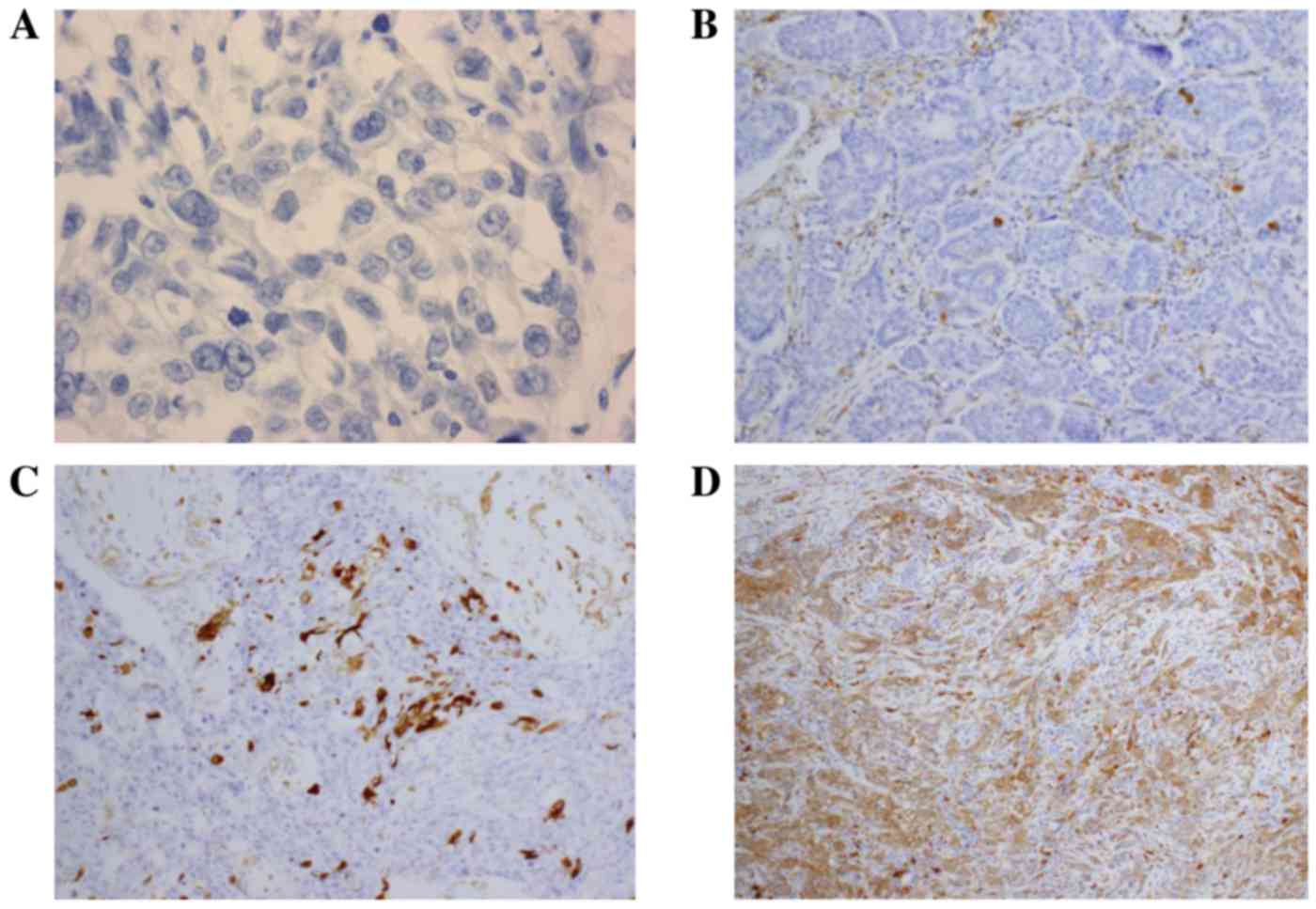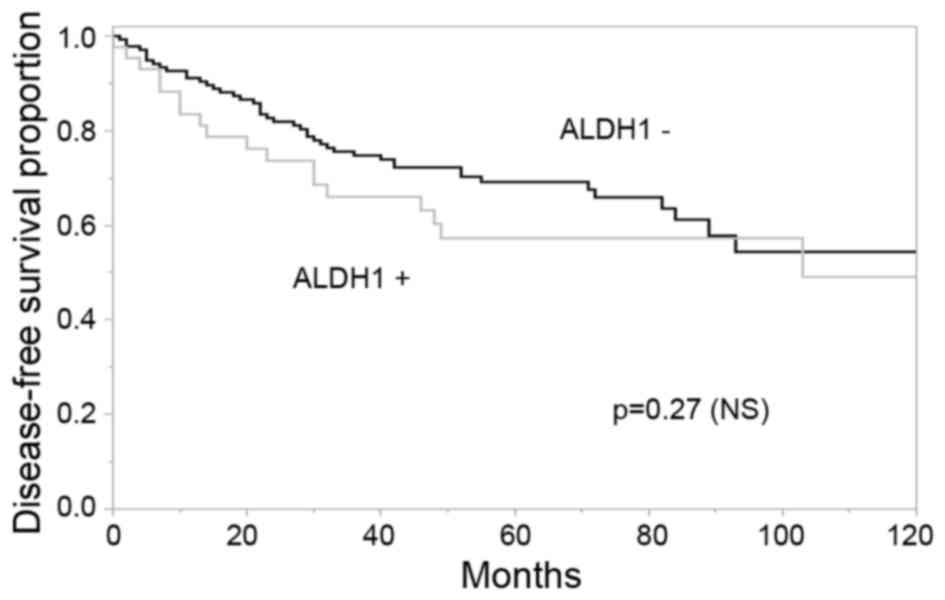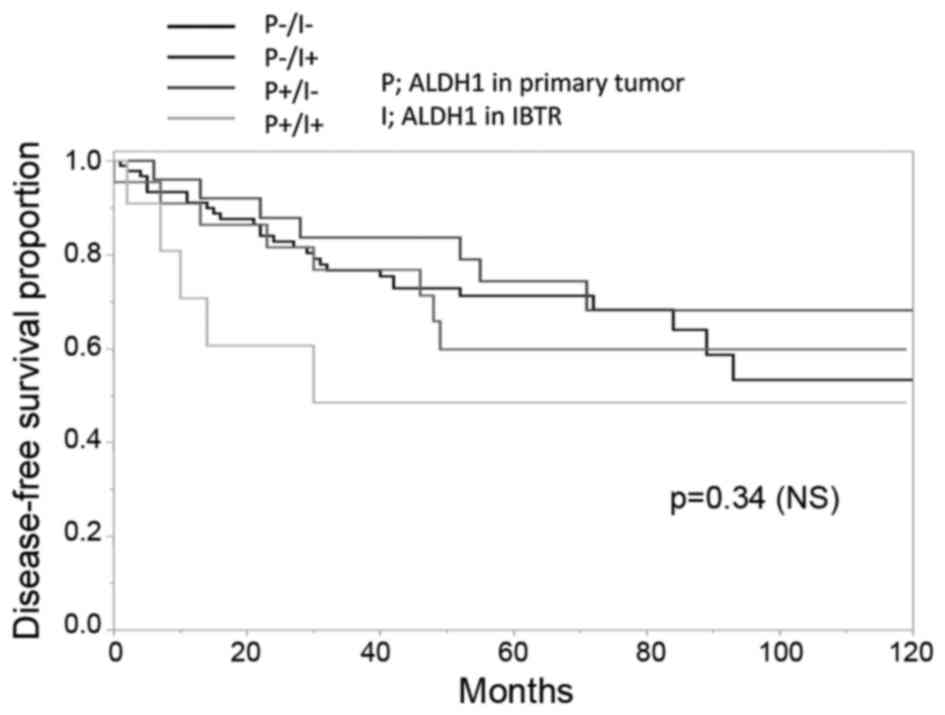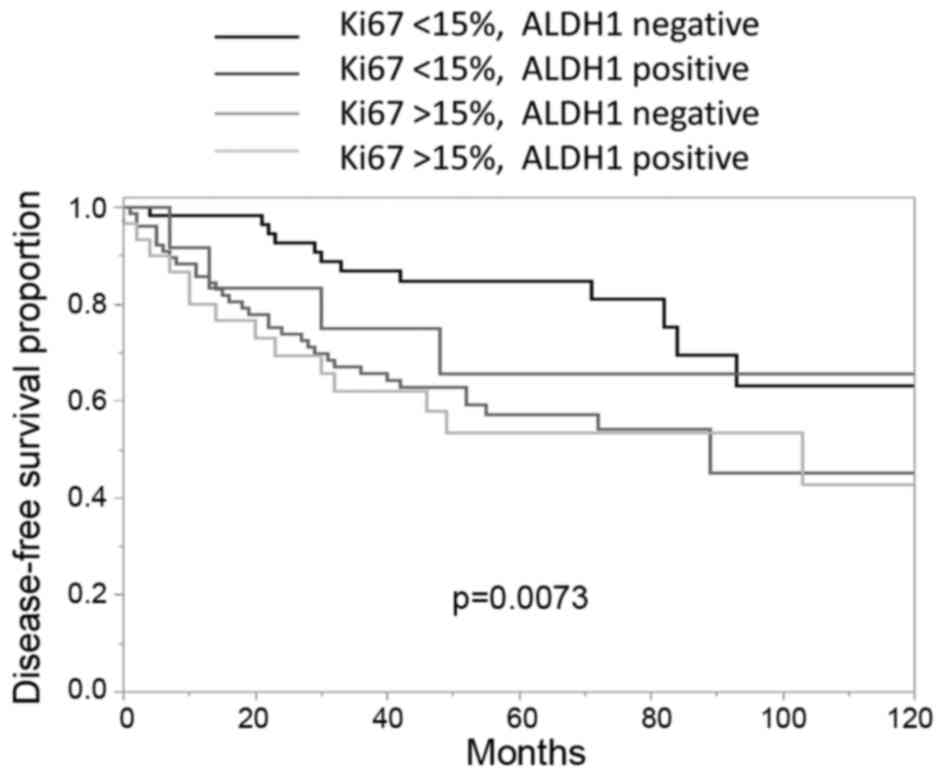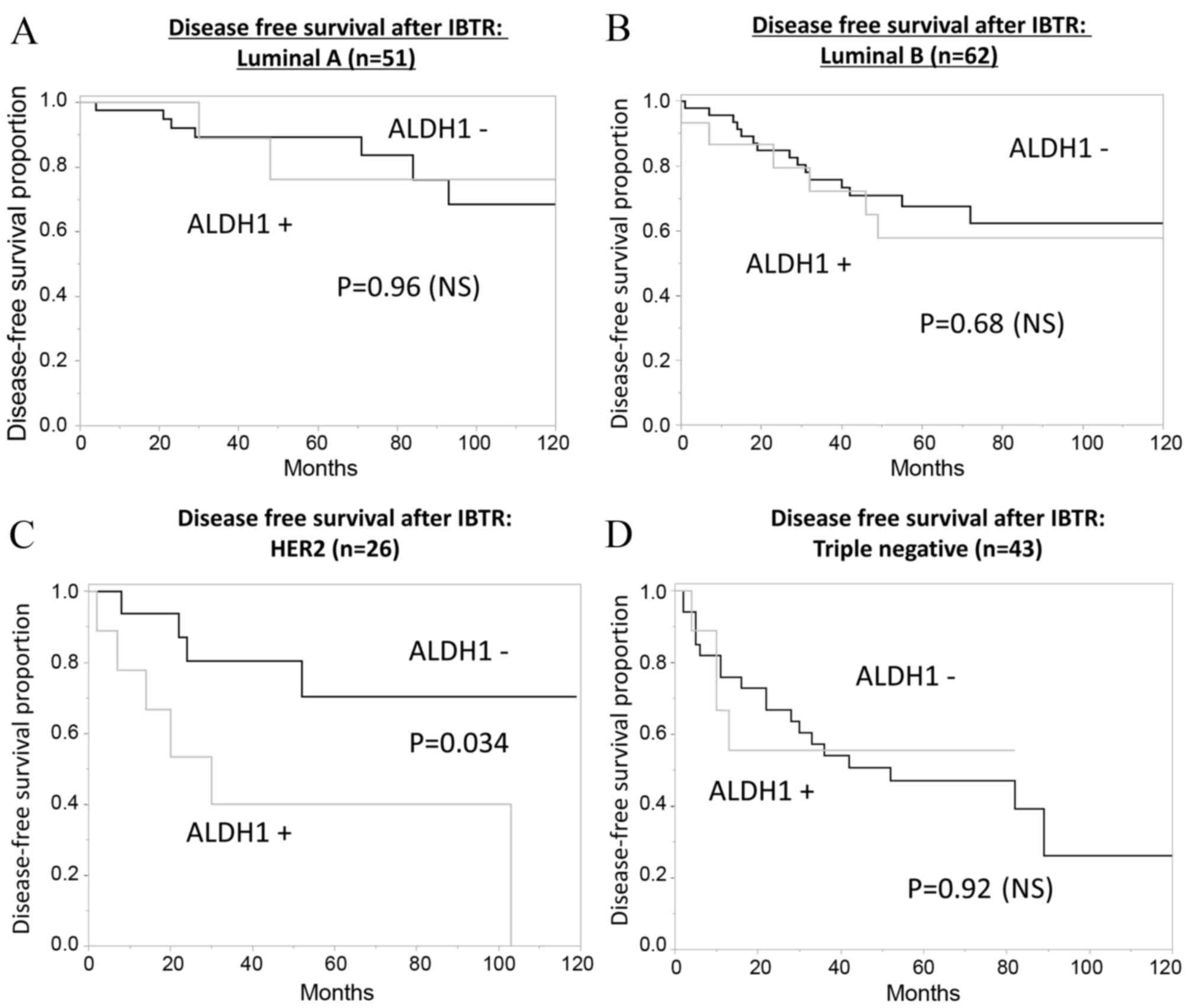Evaluation of ALDH1 expression in ipsilateral breast cancer recurrence
- Authors:
- Published online on: December 27, 2016 https://doi.org/10.3892/ol.2016.5538
- Pages: 1071-1077
-
Copyright: © Shien et al. This is an open access article distributed under the terms of Creative Commons Attribution License.
Abstract
Introduction
Breast conserving surgery (BCS) is a standard procedure for the treatment of early-stage breast cancer (1). It has been demonstrated in previous studies that the 10-year overall survival (OS) rate of patients treated with BCS (65%) is similar to that of those treated with mastectomy (66%) (1,2); however, there is a higher risk of ipsilateral breast tumor recurrence (IBTR) following BCS (3). As IBTR is associated with an increased risk of distant disease and mortality, adjuvant radiation therapy of the residual breast tissue following BCS is often required to decrease the risk of IBTR (3). Furthermore, adjuvant hormone therapy and chemotherapy, which are used for the majority of patients, may prevent IBTR (3); however, a considerable number of IBTR cases are diagnosed following BCS administered with an adjuvant therapy (4,5).
The risk factors for developing IBTR have yet to be determined, and further studies of the tumor biology of IBTR are required to identify tumor characteristics that may be used in the selection of an appropriate treatment strategy. A previous study revealed a significant difference in distant disease-free survival following IBTR depending on the subtype of breast cancer tissues present, as determined by immunohistochemical staining (6). In particular, increased or persistently high Ki-67 expression levels in cases of IBTR were significantly associated with a poorer prognosis (7).
A predictive prognostic factor that has gained significant interest in association with breast cancer is the presence of cancer stem cells (CSCs). CSCs have self-renewal and multi-lineage differentiation capacities and are frequently resistant to conventional anti-cancer drug and radiation therapies (8). The presence of CSCs may be an important factor in cases of IBTR occurring subsequent to BCS and adjuvant therapy. However, to the best of our knowledge, there are no previous studies that have discussed the presence of CSCs within IBTR tissues. Aldehyde dehydrogenase 1 (ALDH1) is a marker of CSCs (9) that may be easily evaluated in primary breast cancer tissues and is a potentially useful prognostic factor. In the current study, the expression levels of ALDH1 in the primary lesion and in IBTR tissues were investigated, and their association with other clinicopathological factors and the prognostic impact of ALDH1 in IBTR was determined.
Materials and methods
Patients and samples
A total of 271 consecutive patients with histologically diagnosed IBTR without distant metastases, who underwent definitive surgery for IBTR between 1989 and 2008, were recruited from eight institutions (Okayama University Hospital, Okayama; The Cancer Institute Hospital of the Japanese Foundation for Cancer Research, Tokyo; Kumamoto City Hospital, Kumamoto National Hospital Organization; Osaka National Hospital, Osaka; St. Luke's International Hospital, Tokyo; Osaka Medical Center for Cancer and Cardiovascular Diseases, Osaka; Osaka Medical College, Osaka; Kyoto Prefectural University of Medicine, Kyoto) in Japan. Each institution's review board approved this retrospective study. The inclusion criteria for were as follows: i) The patient was undergoing BCS and axillary surgery (sentinel lymph node biopsy was only permitted if the nodes had no metastasis); ii) IBTR was histologically determined; and iii) the patient was undergoing definitive surgery for IBTR at a time prior to the year 2008. The exclusion criteria were as follows: i) Presence of synchronous metastases (defined as occurring within three months); ii) bilateral breast cancer; iii) history of prior malignancies other than breast cancer; and iv) presence of tumors located in the skin or muscle only, without associated parenchymal disease. Of the 271 IBTR cases, 182 met the criteria and were included in the present study, which investigated the frequency and prognostic impact of the ALDH1 expression profile in IBTR and primary breast cancer tissue.
Immunohistological examination
Estrogen receptor (ER) and progesterone receptor (PgR) status were determined by immunohistochemistry (IHC) (7), and those tumors with ≥10% positively stained tumor cells were classified as being positive for ER. Tissue samples were considered positive for human epidermal growth factor receptor 2 (HER2) if scored as 3+, or if fluorescence in situ hybridization identified a HER2/chromosome 17 ratio of >2.0 (7). The ER and HER2 status in each tissue sample were evaluated independently in each institution. Proliferation activity was assessed by immunostaining with the Ki-67 antibody (clone MIB-1, cat. no., M7240; dilution, 1:100; Dako, Glostrup, Denmark) using an autostainer (Benchmark XT; Ventana Medical Systems, Inc., Tucson, AZ, USA). Ki-67 staining was centrally evaluated by one pathologist (Kumamoto City Hospital) who was blinded to the clinical data. The proportion of proliferating cells was determined by counting ≥500 tumor cells in hot spots, defined as having a dense concentration of positive cancer nuclei in each tumor according to a previously described protocol (10,11) Breast cancer tissues were classified using the IHC results, according to a previously described protocol (6), into the following subtypes: Triple-negative (ER-, PgR- and HER2-negative); HER2 (HER2-positive, ER- and PgR-negative); luminal A (ER- and/or PgR-positive, HER2-negative and Ki-67 <15%); and luminal B (ER-positive, HER2-negative and Ki-67 ≥15%, or ER-positive and HER2-positive).
IHC was used to evaluate the ALDH1 expression levels in the surgical tissue specimens of primary cancer and IBTR cases that were identified to be invasive carcinomas. The antibody used was anti-ALDH1 (clone 44; #611195; dilution, 1:250; BD Biosciences, Franklin Lakes, NJ, USA). Imaging analysis of ALDH1 expression in the breast tumor tissues was performed using fluorescence microscopy with one selected high-power field (magnification, 400x; Olympus BX53; Olympus Corporation, Tokyo, Japan) per case, as the immunoreactivity of ALDH-1 was approximately homogeneous with the results from a previous study (12–14). The percentage of ALDH1-positive cells was determined as described in previous studies (12–14), in which the tumor specimens were classified into positive and negative groups based on the IHC staining for ALDH1, with positive defined as >1% of tumor cells exhibiting positive staining. Representative results of IHC staining for ALDH1 in breast cancer tissues are presented in Fig. 1.
Statistical analysis
Disease-free survival (DFS) was calculated as the duration from the time of initial surgery for IBTR to the diagnosis of a recurrence. Differences in clinicopathological data were compared using the χ2 test. For comparison between patients with recurrent disease and the recurrence-free patients, the odds ratios for differing variables were assessed by applying a logistic regression model for univariate and multivariate analyses. Survival curves were calculated using the Kaplan-Meier method, and the log-rank test was used to evaluate the statistical significance of the differences in survival among the patient subgroups. Varations between overall survival curves were determined using a log-rank test. For univariate and multivariate analyses, the Cox regression method was used to evaluate the influence of the variables on survival. All of the data were analyzed with the use of JMP version 11.0.0 statistical software (SAS Institute, Cary, NC, USA). P<0.05 was considered to indicate a statistically significant difference.
Results
Patient characteristics
Patient clinical characteristics are presented in Table I. A total of 271 patients were registered for the current study, of which 182 IBTR tissue specimens were examined for the expression of ALDH1. The median ages of the patients at the time of initial breast surgery and surgery for IBTR were 46 years (range, 26–84 years) and 51 years (range, 29–88 years), respectively. In the primary tumor tissues, the proportions of cells that were positive for ER, PgR and HER2 were 55, 46 and 11%, respectively; these values were 62, 43 and 22% in the IBTR tissue samples. Following primary surgery, 10% of patients exhibited a positive surgical margin. Adjuvant radiation therapy was administered to 51% of the patients. The median duration from initial surgery to a diagnosis of IBTR was 46 months (range, 2–206 months).
ALDH1 expression in primary tumor and IBTR
The expression levels of ALDH1 in the primary tumor and IBTR tissues are presented in Table II. A total of 37 (20%) primary tumor tissue samples and 43 (23%) IBTR tissue specimens were ALDH1 positive (>1% positively stained cells). As a minority of tissue samples were classified as 2+ (primary tumor, 2%; IBTR, 4%) or 3+ (primary tumor, 2%; IBTR, 3%), it was determined that tissues with >1% ALDH1-positive cells would be considered positive cases. The concordance of the ALDH1 expression status between the primary tumor and IBTR cases is presented in Table III; the total concordance rate was 68%.
Correlation between ALDH1/Ki-67 expression and disease-free survival
There was no significant association observed between the rate of DFS following IBTR and ALDH1 expression status in IBTR tissues (Fig. 2); however, patients who exhibited ALDH1-positive tissues in the primary tumor and the IBTR had the poorest DFS (Fig. 3). Multivariate analysis revealed that Ki-67 ≥15% (odds ratio, 2.31; P=0.003) and ER-positive status (odds ratio, 0.48; P=0.027) were statistically significant predictive factors for DFS following IBTR (Table IV); however, ALDH1 did not have prognostic value (P=0.513).
Table IV.Multivariate analysis using the Cox proportional hazards model to identify predictors of disease-free survival. |
According to ALDH1 and Ki-67 statuses, the tissue samples were further subdivided (Fig. 4). The ALDH1-negative patients with low Ki-67 expression (<15%) had typically better outcomes compared with those patients exhibiting high Ki-67 expression levels (≥15%). However, there were no significant differences observed between the Ki-67 <15%, ALDH1-positive group and the Ki-67 <15%, ALDH1-negative group.
ALDH1 expression according to subtype
When classified according to ER, HER2 and Ki-67 expression profiles, the subtype distribution of IBTR was as follows: Luminal A, 51 patients (28%); luminal B, 62 patients (34%); HER2, 26 patients (14%); and triple-negative, 43 patients (24%). The proportions of each of the subtypes that were positive for ALDH1 were as follows: Luminal A, 20%; luminal B, 24%; HER2, 35%; and triple-negative, 21% (Table V). The proportions of patients that received adjuvant drug therapy following IBTR for luminal A, luminal B, HER2 and triple-negative types were 93, 92, 58 and 56%, respectively. A total of 7 patients (27%) with the HER2 subtype received trastuzumab following IBTR surgery.
Table V.Expression of ALDH1 according to ER and HER2 status in cases of ipsilateral breast tumor recurrence. |
There was no significant correlation observed between ER, PgR, HER2 or Ki-67 expression status and ALDH1 expression status, or between ALDHI and the specific tissue subtype (Table V). Furthermore, there was no significant association between the administration of adjuvant therapy following primary surgery and ALDH1 expression levels in IBTR tissues (Table VI).
Table VI.Association between adjuvant therapy administered following the primary surgery and ALDH1 expression levels in IBTR tissues. |
When the prognosis was analyzed with regard to ALDH1 expression and tissue subtype (Fig. 5A-D), the expression status of ALDH1 in IBTR tissues of a HER2 subtype was observed to be a significant prognostic factor for DFS (P=0.034; Fig. 5C).
There was no significant difference observed in the rates of adjuvant trastuzumab administration between the ALDH1-positive and -negative groups (ALDH1-positive, 25%; ALDH1-negative, 16%).
Discussion
To the best of our knowledge, the present study is the first to investigate the frequency and prognostic value of ALDH1 expression in IBTR tissues. The cut-off level for the classification of positive ALDH1 expression was set at >1% in the current study, as there is no standardized cut-off level or method currently available. The ALDH1 positive cells were counted in hot spots, and positive ALDH1 expression was detected in 20% of the primary tumor samples and 23% of the IBTR tissue samples. The frequency of patients with ALDH1-expressing primary breast cancer (20%) in the current study was similar to that observed in previous studies (19, 17.5%) (10,11); however, the ALDH1 expression the in IBTR group (23%) was higher. It was hypothesized that this variation was due to the dissimilarities between the IBTR and primary tumors. IBTRs included new primary tumors and true recurrences following adjuvant therapy. Therefore, ALDH1-positive cancer stem cells within true recurrence were able to survive following adjuvant systemic and radiation therapy and may be not similar to the cancer cells within the primary tumor. A previous study revealed that the frequency of ALDH1 positive cells in metastatic tumors is relatively high compared with primary tumors (14). This discrepancy may be due to there being no definitive ALDH1 cut-off level; the cut-off level (>1%) used for the present study was lower than the value used in previous reports (12–14). The total number of IBTR tissue samples used in the current study was relatively low, compared with previous reports that analyzed ALDH1 expression in primary breast tumors. Therefore, the associations between ALDH1 expression, tumor subtypes and clinical data could not be analyzed.
A similar expression rate for ALDH1 was observed in the primary tumor and IBTR tissue specimens. The concordance rate between ALDH1 expression in primary tumors and associated IBTR was 68%. It was previously reported that variation in the ER, HER2 and Ki-67 statuses between the primary tumors and IBTR tissues was observed in 16.2, 13.7 and 36.8% of cases, respectively (7). The discordance rates for ALDH1 expression and Ki-67 status were higher, compared with ER, PgR and HER2 in our previous study (14). A number of previous studies have evaluated the variations between primary tumors and distant metastases and presented similar results to those observed in the current study (12,15,16). The discordance rates for the expression of ER, HER2, Ki-67 and ALDH1 between primary breast tumor tissues and lung metastases were 0, 21, 43 and 50%, respectively (14), and the corresponding rates for primary breast tumor tissue and axillary lymph node metastases were 12.5, 17.5, 22.5 and 42.5% (12), respectively. It was hypothesized that a reason for the variation in the expression of these specific biomarkers may be the exposure of metastatic tumor tissues to adjuvant systemic chemotherapy or radiation therapy (17).
Tanei et al (18) identified a difference in ALDH1 expression levels in breast tumor tissues prior to and following neoadjuvant chemotherapy (NAC). Although the association between adjuvant therapy and ALDH1 expression levels in IBTR tissues was investigated in the current study, no significant correlation was demonstrated. However, as the current study was retrospective, further evaluation may be required. The present study also included a mixture of patient tissue samples consisting of ‘true IBTR’ and ‘new primary tumors’; new primary tumors are not expected to have any correlation with the first primary tumor (19–21). The timing of diagnosis of IBTR was distinct from that of the diagnosis following NAC. The post-NAC surgery was performed immediately following the end of systemic therapy. However, the duration between the administration of systemic therapies and time of surgery for IBTR were not homogeneous. There were many cancer stem cells present in tissue specimens following NAC administration, as they are resistant to systemic therapy (18). Therefore, ALDH1 expression levels in IBTR may be varied according to the timing of surgery following systemic therapy.
In previous reports, ALDH1 expression in primary breast tumors was identified to be an independent predictor of early tumor relapse of invasive ductal carcinoma (22), particularly in patients with triple-negative breast cancer (23,24). In the present study, no significant correlation was observed between ALDH1 expression in primary tumors or IBTR tissues, and the prognosis of patients with IBTR. However, the results suggested that low Ki-67 and high ER expression levels in IBTR tissues were significantly associated with improved prognosis. Furthermore, the expression levels of Ki-67 and ALDH1 in IBTR tissues were determined to be significant predictors of poor prognosis and a short DFS time.
Subgroup analysis identified no significant correlation between the tumor subtype and ALDH1 expression levels; however, the expression levels of ALDH1 were significantly associated with prognosis in HER2-positive IBTR, possibly due to HER2-positive IBTR tissue including numerous new primary tumors. In the current study, the rate of HER2 expression in IBTRs (22%) was higher than that in primary tumors (11%), and 54% of primary tumors in HER2-type IBTR tissues were diagnosed as HER2-negative or unknown. Adjuvant trastuzumab therapy was administered to three patients. Adjuvant trastuzumab following primary surgery is recommended for patients with HER2-type breast cancer (25); however, no prospective studies have been conducted to examine the efficacy of adjuvant trastuzumab for IBTR. A total of 74% of the patients with HER2-type IBTR did not receive trastuzumab. A number of patients with luminal A or B subtypes of breast cancer received adjuvant hormonal therapy. Our previous study reported that the IBTR tumor subtype is more important in predicting treatment outcomes than the subtype of the primary tumor (6). There was no significant difference in the proportions of patients that received adjuvant trastuzumab treatment between cases of ALDH1-positive and ALDH1-negative IBTR in the present study. Therefore, trastuzumab may reduce the variation in disease free survival between patients with ALDH1-positive and ALDH1-negative IBTR.
In the present study, only tissue specimens from patients with IBTR were evaluated and no control specimens from breast cancer without IBTR were included. Therefore, a comparison between patients with and without IBTR is required in future studies. Further studies are required to evaluate the value of ALDH1 expression as a predictor for IBTR. It is possible that ALDH1 expression levels in primary tumors are not a significant predictor of IBTR, as it was identified that the expression levels of ALDH1 in the primary tumor tissue samples of the patients with IBTR were not higher compared with previous studies of patients with primary breast tumors. Further studies are required to investigate this.
In conclusion, the expression profile of ALDH1 in IBTR tissue specimens was retrospectively analyzed and ALDH1 was not demonstrated to be an independent prognostic factor. However, ALDH1 expression levels may be a useful prognostic factor in certain subgroups or when examined in combination with other factors, including Ki67 or breast cancer subtypes. Further studies regarding the prognostic importance of ALDH1 expression levels in IBTR are required, with a larger sample number and a prospective approach.
Acknowledgements
This study was supported in part by Grants-in-Aid for Scientific Research from the Japanese Breast Cancer Society (grant no. H25-26), and the Health and Labour Sciences Research Expenses for Commission, Applied Research for Innovative Treatment of Cancer (grant no. H26-applied-general-043) from the Ministry of Health, Labour and Welfare, and Japan Agency for Medical Research and Development.
References
|
van Dongen JA, Voogd AC, Fentiman IS, Legrand C, Sylvester RJ, Tong D, van der Schueren E, Helle PA, van Zijl K and Bartelink H: Long-term results of a randomized trial comparing breast-conserving therapy with mastectomy: European organization for research and treatment of cancer 10801 trial. J Natl Cancer Inst. 92:1143–1150. 2000. View Article : Google Scholar : PubMed/NCBI | |
|
Morris AD, Morris RD, Wilson JF, White J, Steinberg S, Okunieff P, Arriagada R, Lê MG, Blichert-Toft M and van Dongen JA: Breast-conserving therapy vs mastectomy in early-stage breast cancer: A meta-analysis of 10-year survival. Cancer J Sci Am. 3:6–12. 1997.PubMed/NCBI | |
|
Clarke M, Collins R, Darby S, Davies C, Elphinstone P, Evans V, Godwin J, Gray R, Hicks C, James S, et al: Effects of radiotherapy and of differences in the extent of surgery for early breast cancer on local recurrence and 15-year survival: An overview of the randomised trials. Lancet. 366:2087–2106. 2005. View Article : Google Scholar : PubMed/NCBI | |
|
Veronesi U, Cascinelli N, Mariani L, Greco M, Saccozzi R, Luini A, Aguilar M and Marubini E: Twenty-year follow-up of a randomized study comparing breast-conserving surgery with radical mastectomy for early breast cancer. N Engl J Med. 347:1227–1232. 2002. View Article : Google Scholar : PubMed/NCBI | |
|
Fisher B, Anderson S, Bryant J, Margolese RG, Deutsch M, Fisher ER, Jeong JH and Wolmark N: Twenty-year follow-up of a randomized trial comparing total mastectomy, lumpectomy, and lumpectomy plus irradiation for the treatment of invasive breast cancer. N Engl J Med. 347:1233–1241. 2002. View Article : Google Scholar : PubMed/NCBI | |
|
Ishitobi M, Okumura Y, Arima N, Yoshida A, Nakatsukasa K, Iwase T, Shien T, Masuda N, Tanaka S, Tanabe M, et al: Breast cancer subtype and distant recurrence after ipsilateral breast tumor recurrence. Ann Surg Oncol. 20:1886–1892. 2013. View Article : Google Scholar : PubMed/NCBI | |
|
Okumura Y, Nishimura R, Nakatsukasa K, Yoshida A, Masuda N, Tanabe M, Shien T, Tanaka S, Arima N, Komoike Y, et al: Change in estrogen receptor, HER2 and Ki-67 status between primary breast cancer and ipsilateral breast cancer tumor recurrence. Eur J Surg Oncol. 41:548–552. 2015. View Article : Google Scholar : PubMed/NCBI | |
|
Wicha MS, Liu S and Dontu G: Cancer stem cells: An old idea-a paradigm shift. Cancer Res. 66:1883–1890, 1895–1896. 2006. View Article : Google Scholar : PubMed/NCBI | |
|
Ginestier C, Hur MH, CharafeJauffret E, Monville F, Dutcher J, Brown M, Jacquemier J, Viens P, Kleer CG, Liu S, et al: ALDH1 is a marker of normal and malignant human mammary stem cells and a predictor of poor clinical outcome. Cell Stem Cell. 1:555–567. 2007. View Article : Google Scholar : PubMed/NCBI | |
|
Arima N, Nishimura R, Osako T, Nishiyama Y, Fujisue M, Okumura Y, Nakano M, Tashima R and Toyozumi Y: The importance of tissue handling of surgically removed breast cancer for an accurate assessment of the Ki-67 index. J Clin Pathol. 69:255–259. 2016. View Article : Google Scholar : PubMed/NCBI | |
|
Arima N, Nishimura R, Osako T, Nishiyama Y, Fujisue M, Okumura Y, Nakano M, Tashima R and Toyozumi Y: A comparison of the hot spot and the average cancer cell counting methods and the optimal cutoff point of the Ki-67 index for luminal type breast cancer. Oncology. 90:43–50. 2016. View Article : Google Scholar : PubMed/NCBI | |
|
Nogami T, Shien T, Tanaka T, Nishiyama K, Mizoo T, Iwamto T, Ikeda H, Taira N, Doihara H and Miyoshi S: Expression of ALDH1 in axillary lymph node metastases is a prognostic factor of poor clinical outcome in breast cancer patients with 1–3 lymph node metastases. Breast Cancer. 21:58–65. 2014. View Article : Google Scholar : PubMed/NCBI | |
|
Ito M, Shien T, Omori M, Mizoo T, Iwamoto T, Nogami T, Motoki T, Taira N, Doihara H and Miyoshi S: Evaluation of aldehyde dehydrogenase 1 and transcription factors in both primary breast cancer and axillary lymph node metastases as a prognostic factor. Breast Cancer. 23:437–444. 2016. View Article : Google Scholar : PubMed/NCBI | |
|
Nogami T, Shien T, Tanaka T, Doihara H, Taira N, Takabatake D, Nishimura R, Nishiyama K, Mizoo T and Ohsumi S: The discordance between primary breast cancer lesions and pulmonary metastatic lesions in expression of aldehyde dehydrogenase 1-positive cancer cells. Breast Cancer. 21:698–702. 2014. View Article : Google Scholar : PubMed/NCBI | |
|
Yeung C, Hilton J, Clemons M, Mazzarello S, Hutton B, Haggar F, Addison CL, Kuchuk I, Zhu X, Gelmon K and Arnaout A: Estrogen, progesterone, and HER2/neu receptor discordance between primary and metastatic breast tumours-a review. Cancer Metastasis Rev. 35:427–437. 2016. View Article : Google Scholar : PubMed/NCBI | |
|
Rossi S, Basso M, Strippoli A, Dadduzio V, Cerchiaro E, Barile R, D'Argento E, Cassano A, Schinzari G and Barone C: Hormone receptor status and HER2 expression in primary breast cancer compared with synchronous Axillary metastases or recurrent metastatic disease. Clin Breast Cancer. 15:307–312. 2015. View Article : Google Scholar : PubMed/NCBI | |
|
Shien K, Toyooka S, Ichimura K, Soh J, Furukawa M, Maki Y, Muraoka T, Tanaka N, Ueno T, Asano H, et al: Prognostic impact of cancer stem cell-related markers in non-small cell lung cancer patients treated with induction chemoradiotherapy. Lung Cancer. 77:162–167. 2012. View Article : Google Scholar : PubMed/NCBI | |
|
Tanei T, Morimoto K, Shimazu K, Kim SJ, Tanji Y, Taguchi T, Tamaki Y and Noguchi S: Association of breast cancer stem cells identified by aldehyde dehydrogenase 1 expression with resistance to sequential paclitaxel and epirubicin-based chemotherapy for breast cancers. Clin Cancer Res. 15:4234–4241. 2009. View Article : Google Scholar : PubMed/NCBI | |
|
Benson JR and Rovere GQ della: Ipsilateral breast cancer recurrence. Breast. 17:12–18. 2008. View Article : Google Scholar : PubMed/NCBI | |
|
Chen SL and Martinez SR: The survival impact of the choice of surgical procedure after ipsilateral breast cancer recurrence. Am J Surg. 196:495–499. 2008. View Article : Google Scholar : PubMed/NCBI | |
|
McGrath S, Antonucci J, Goldstein N, Wallace M, Mitchell C, Grills I, Jolly S, Kestin L and Vicini F: Long-term patterns of in-breast failure in patients with early stage breast cancer treated with breast-conserving therapy: A molecular based clonality evaluation. Am J Clin Oncol. 33:17–22. 2010. View Article : Google Scholar : PubMed/NCBI | |
|
Zhong Y, Lin Y, Shen S, Zhou Y, Mao F, Guan J and Sun Q: Expression of ALDH1 in breast invasive ductal carcinoma: An independent predictor of early tumor relapse. Cancer Cell Int. 13:602013. View Article : Google Scholar : PubMed/NCBI | |
|
Ohi Y, Umekita Y, Yoshioka T, Souda M, Rai Y, Sagara Y, Sagara Y, Sagara Y and Tanimoto A: Aldehyde dehydrogenase 1 expression predicts poor prognosis in triple-negative breast cancer. Histopathology. 59:776–780. 2011. View Article : Google Scholar : PubMed/NCBI | |
|
Zhou L, Li K, Luo Y, Tian L, Wang M, Li C and Huang Q: Novel prognostic markers for patients with triple-negative breast cancer. Hum Pathol. 44:2180–2187. 2013. View Article : Google Scholar : PubMed/NCBI | |
|
Moja L, Tagliabue L, Balduzzi S, Parmelli E, Pistotti V, Guarneri V and D'Amico R: Trastuzumab containing regimens for early breast cancer. Cochrane Database Syst Rev. 18:CD0062432012. |



